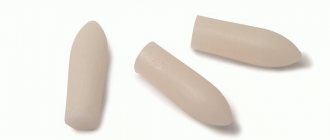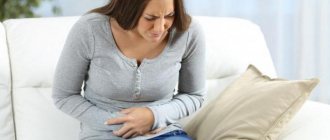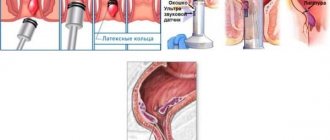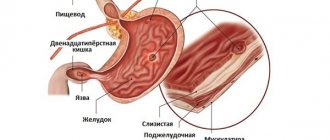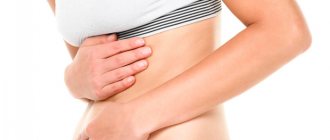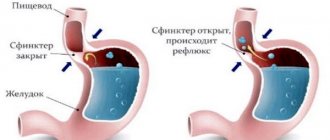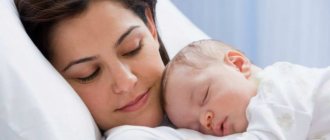Causes of thrombosis in hemorrhoids
Thrombosis of the hemorrhoidal node is a common complication of hemorrhoids, which is associated with impaired blood circulation in the anorectal area, the formation of a blood clot (thrombus) in the cavernous plexuses of the rectum.
The patient feels severe pain in the rectum area, not associated with the process of defecation, and a constant sensation of a foreign body in the anus. According to the ICD, hemorrhoidal thrombosis has code K.64.5
The rectum ampulla is surrounded by venous caverns, which, together with the anal sphincter, prevent the arbitrary release of gases and feces from the anus. These formations are permeated with vessels, which, under the influence of various negative factors, lose their tone. As a result, the blood begins to stagnate, the veins expand and become deformed. This is how hemorrhoidal nodules are formed.
In the process of life, work, and sports, a person’s intra-abdominal pressure changes. Deformed vessels are not able to cope with it, so the body turns on “protection”, turning stagnant blood into a blood clot. This is the main cause of thrombosis or thrombophlebitis. Contribute to the development of pathology:
- hereditary predisposition;
- bad habits;
- alcoholism, diet violations;
- constipation or diarrhea;
- constant lifting of weights;
- physical inactivity;
- "sedentary work;
- chronic inflammation of the pelvic organs;
- pregnancy;
- low temperatures.
Thrombosis of internal hemorrhoids develops due to pinching of the cones by the sphincter and occurs rarely .
What is the danger of thrombophlebitis of hemorrhoidal veins
In ordinary life, it is possible to injure the wall of the external hemorrhoid when performing hygiene procedures. After this, with normal blood clotting, thrombosis of the blood vessels occurs, which stops the bleeding. Then, the blood clot resolves without any consequences. But if thrombus formation occurs without injury, against the background of negative changes in the circulatory system, a condition that is dangerous to human life arises:
- acute thrombosis requiring urgent surgery;
- sepsis;
- atypia with transformation into cancer;
- detachment of a blood clot from the cavity wall with transfer through the bloodstream to the coronaries, cerebral vessels, pulmonary artery and the development of stroke, heart attack, pulmonary embolism.
Each condition can be fatal. That is why any person suffering from hemorrhoidal disease must consult a doctor.
Types and degrees of disease
The localization of hemorrhoids with thrombosis is the basis of the classification:
- outer;
- interior;
- combined thrombophlebitis of the node.
The severity of symptoms determines the severity of the pathology:
- first - there are no signs of inflammation of the caverns;
- second - thrombosed nodes of any location give the first symptoms: pain, bruising, swelling of the anus ;
- third - inflammation affects nearby tissues, complications arise.
According to the severity of the process, hemorrhoidal thrombosis is distinguished between acute (complicated) and chronic (recurrent).
Clinical symptoms
The photo shows live external thrombosis of a hemorrhoid.
The very first symptom or sign of hemorrhoidal thrombosis is sudden pain that is accompanied by discomfort in the anorectal area. The nodule formed as a result of thrombosis begins to grow, and the person feels a foreign body in the anus. The nature of the pain changes. If with hemorrhoids of any localization the pain is caused by the act of defecation, then a blood clot in the venous plexus causes constant pain that is not associated with anything.
The clinical picture develops gradually and corresponds to the stages of pathology, which are presented in the table.
| Pathology stage | Symptoms and signs |
| First |
|
| Second |
|
| Third |
|
Symptoms and degrees of thrombosis of hemorrhoids
At an early stage, thrombosis of hemorrhoids does not manifest itself in any way, the disease is asymptomatic. Over time, the patient begins to experience pain in the anus. Intense discomfort increases with bowel movements, walking, coughing and sneezing. The leading sign of thrombosis of hemorrhoids is the enlargement and thickening of the formations. The patient feels a foreign object in the rectum.
The pain intensifies with pushing, so defecation in any case brings discomfort. In most cases, an inflammatory process develops and pus collects in the hemorrhoids. Hyperthermia, general weakness of the body, malaise, and fever are observed. The patient suffers from signs of intoxication of the body. These include nausea and vomiting, lack of appetite, belching, and flatulence.
The manifestation of clinical symptoms of hemorrhoidal thrombosis depends on the severity:
- The first stage - at the initial stage of the pathology, there are no inflammatory processes. On average, the patient's condition is satisfactory. The nodules become denser and increase in size, but there is no bleeding. There is slight discomfort when palpating the bumps. During defecation, pain occurs, which intensifies with pushing. Redness and swelling appear in the anus.
- The second degree of thrombosis of hemorrhoids is characterized by the development of an inflammatory process in the cones. The anus is surrounded by hyperemia, swelling, and redness. Palpation of the lumps causes acute pain. There may be slight bleeding during bowel movements.
- At the third stage of the disease, the above symptoms are present. The painful syndrome practically does not disappear even after taking painkillers. The process of inflammatory infiltration develops in the subcutaneous fatty tissue of the anal area. In some cases, inflammatory infiltration extends to the entire loose pararectal tissue. Palpation brings unbearable pain, which intensifies. Hemorrhoids have increased in size, so they begin to fall out when moving. They become purple or blue in color.
It is recommended to visit a proctologist as early as possible in order to diagnose the pathology in time.
Possible complications
The progression of thrombophlebitis of hemorrhoids causes a number of complications requiring medical intervention:
- bleeding;
- varicose veins of the anal veins;
- abscess of soft tissues of the perianal area;
- necrosis of thrombosed nodes with symptoms of severe intoxication;
- addition of a secondary infection;
- anal dermatitis;
- postoperative fistulas, suture dehiscence, narrowing of the anus.
Any of the complications requires prompt attention to a specialist.
Diagnostics
As a rule, an accurate diagnosis of hemorrhoidal vein thrombosis is made quickly, based on a visual examination of the anorectal area, a characteristic clinic. Thrombosis of the external hemorrhoid is localized under the pectineal line; it is inflamed, cyanotic, and painful. Internal - accompanied by a pronounced furrow between the prolapsed node and the swollen skin of the anorectal area. If there is no prolapse, a revision of the rectum is needed, which is carried out under local anesthesia due to unbearable pain.
Laboratory and instrumental methods are used:
- OAC, OAM – assessment of the patient’s general condition;
- coagulogram, electrocoagulography, detailed hemostasiogram - determine signs of hemostasis impairment;
- rectoscopy - for severe pain with suspected cancer, strangulation of a polyp, paraproctitis in the acute phase.
Without an accurate diagnosis, it is impossible to prescribe adequate therapy.
Types and stages
To prescribe adequate treatment for the disease, thrombosis is classified according to several criteria. Depending on the location of the nodes, internal, external (external) and mixed (combined) thrombosis are distinguished. With internal, a blood clot forms in the internal nodes and cones, with external, the thrombotic process develops in the vessels of external nodes, and with combined, the formation of blood clots occurs both inside the rectum and outside it.
Thrombosis of the external hemorrhoid is the most commonly diagnosed type of disease; combined thrombosis is found in very rare cases, but more often leads to complications. Based on the degree of tissue damage, three stages of the disease are distinguished, which successively replace each other in the absence of treatment. The treatment measures taken and the prognosis for recovery will differ at each stage of thrombosis:
| Features | First stage | Second stage | Third stage |
| The presence of an inflammatory process | Absent | Limited | Spreads to tissues adjacent to the hemorrhoid (including fatty tissue) |
| Features of nodes | No visible changes | A sharp increase in size due to the appearance of swelling, compaction, acquisition of a dark red color, bluish tint | High density, localized either inside or inside and outside, necrotic changes in tissues begin |
| Severity of pain syndrome | Sharp, sudden and persistent pain, worsened by mechanical impact | Constant pain, worsens with palpation and compression | It is of a permanent, highly pronounced nature, local anesthesia is required for diagnosis, the anal sphincter is spasmodic |
| Changes in venous tissue | Violation of blood microcirculation in the veins leads to its thickening | A dense thrombus forms, which partially closes the lumen in the vessel | The thrombus almost completely blocks the vessel, preventing the normal outflow of blood |
| Body temperature | Within normal limits | Promoted | High |
| Forecast | Favorable | With timely treatment, favorable, surgical intervention is rarely required | Surgery required |
Modern methods of treatment
How exactly to treat hemorrhoidal thrombosis depends on the location of the pathological process, the stage of the disease, and the degree of severity. A distinction is made between drug therapy and surgical intervention. Sometimes they are combined. Folk recipes are used as background.
Indications for prescribing medications are:
- acute process;
- prevention of complications;
- relapse prevention;
- preparation for surgery;
- postoperative rehabilitation.
Conservative therapy for hemorrhoidal thrombosis is carried out at home: preference is given to tablets, suppositories, ointments, lotions and compresses. Conservative methods of treating thrombosed hemorrhoids do not provide a long-term therapeutic effect, and the risk of relapse is high.
Treatment of acute thrombosis of external and internal hemorrhoids
Hemorrhoidal thrombosis is a complication of chronic hemorrhoids, which occurs in the absence of timely treatment.
A blood clot forms in the enlarged plexuses, which impedes blood circulation and causes inflammation. This complication is often accompanied by pain and other unpleasant symptoms. If hemorrhoidal thrombosis occurs, it is necessary to undergo drug treatment, and if everything is very advanced, the doctor may prescribe surgery. There are both external and internal thrombosis of hemorrhoids, but most often doctors have to deal with the first option. Therapy should be started at the first manifestations of the disease so that an acute inflammatory process does not occur. It is very dangerous to reset an inflamed prolapsed node on your own, because if it is injured, there is a possibility of severe bleeding that will be difficult to stop.
Conservative treatment of hemorrhoidal thrombosis
Treatment of external hemorrhoidal thrombosis is carried out with various ointments and suppositories only if the disease is not advanced. Basically, therapy eliminates unpleasant symptoms; the following drugs are often used for treatment:
- Levomekol ointment for thrombosis of hemorrhoids helps relieve inflammation and prevents its spread to nearby tissues.
- Vishnevsky ointment helps reduce pain, relieves swelling, and also copes well with any kind of inflammation. When used, tissue regeneration improves and healing becomes faster.
- Anestezol is available in the form of suppositories. Suppositories help reduce pain; this is necessary, since a blood clot in hemorrhoids usually causes great suffering to the patient. You can also use Ortofen and other pain-relieving suppositories.
- The venotonic drug Detralex, which is used as part of a complex treatment, will help cure acute inflammation of the nodes. It strengthens the walls of blood vessels and reduces their stretching.
- Thrombolytic agents. For external thrombosis of the hemorrhoid, it is better to use ointments rather than suppositories. Medicines such as Hepatrombin G, Troxevasin, as well as heparin ointment help the blood clot to dissolve without consequences.
If the plexus is small, then conservative treatment usually helps. Properly selected therapy helps to reduce the inflamed node, it gradually shrinks and corrects itself, and the symptoms of the disease disappear.
How to treat hemorrhoidal thrombosis?
For acute hemorrhoidal thrombosis of internal and external nodes, complex treatment is recommended. In addition to the medications prescribed by the doctor, the sick person should follow simple recommendations at home that will help him get better quickly:
- With external hemorrhoidal thrombosis, it is important to exclude any physical activity, as it can be harmful; bed rest should be observed.
- A complication in the form of acute inflammation of the nodes is usually accompanied by unbearable pain, which makes defecation difficult. That is why laxatives and, if necessary, enemas are often prescribed.
- Folk remedies that are used at home can alleviate the suffering of the patient. For example, you can prepare a cool bath of chamomile infusion and sit in it for 10 minutes. You can make compresses from medicinal herbs, they will reduce the inflammatory process.
- A special diet is prescribed, and dishes that can irritate the intestinal mucosa and cause constipation are excluded from the diet. A dairy-vegetable diet is suitable for these purposes.
- You need to wash yourself with water at least 4 times a day, preferably cool.
It is very important to follow the above recommendations when treating thrombosis of hemorrhoids. If the disease is not advanced, then they, along with medicinal ointments and suppositories, will help relieve unpleasant symptoms. A similar complication often occurs during pregnancy, in this case medications are also prescribed, and therapy includes the same recommendations.
Surgical treatment of thrombosis of hemorrhoids
Acute thrombosis of a hemorrhoid is dangerous, so most often a person needs surgical treatment; it is not recommended to try to get rid of the disease at home.
The operation is performed under local anesthesia, it is not complicated, a small incision is made through which the surgeon removes blood clots. The incision is not sutured, it heals on its own, and after a few days there are practically no traces of the operation. Some proctologists offer patients to perform a more complex operation to remove the thrombosed node, so to speak, the very cause of this complication. But in the future it is possible to avoid relapses. This surgical intervention also does not require hospitalization; it is performed under local anesthesia.
Sometimes the external node can rupture on its own, the blood clot comes out and the patient feels much better, the pain goes away, but bleeding appears, which is difficult to stop.
Is it possible to cure thrombosis of hemorrhoids with folk remedies?
Thrombosis can cause dangerous complications, so self-medication should not be considered; it is better to consult a proctologist with this problem. But in complex therapy, you can use folk remedies, which, if used adequately, will be beneficial. Below are a few recipes:
- Hirudotherapy. You can get rid of the disease in a common way using leeches. They suck out the blood, the inflamed node shrinks and then dries up completely. Leeches can be obtained in some pharmacies; one individual is enough for a small node.
- Birch tar. It helps relieve inflammation of the external thrombosed node. You need to lubricate the sore spot with tar until the symptoms go away. And if the node is internal, then it is recommended to insert tampons with it in the posterior approach.
- Birch decoction. It is very effective; to prepare it, take birch leaves (100 g) and pour boiling water (2 l). Once the infusion is ready, it can be used for sitz baths in a warm form.
The methods described above are effective in combination with medications prescribed by a doctor and only if the disease is not very advanced and there are no signs of necrosis or life-threatening inflammation. Hemorrhoidal thrombosis must be treated promptly. With proper therapy, the patient recovers quickly and the unpleasant symptoms no longer bother him.
A thrombosed hemorrhoidal node causes much more suffering to the patient. Rarely can anyone endure severe pain, so people with this disease still consult a doctor. The sooner a person begins treatment, the higher the likelihood that it will be possible to cure the disease with the help of drugs without surgery. And if you treat the initial manifestations of chronic hemorrhoids in a timely manner, you can avoid this dangerous complication.
zhkt.guru>
Pills
They are used as drugs that have a systemic effect, do not irritate the intestines, to dissolve blood clots, normalize microcirculation, and relieve inflammation.
Venotonics
Systemic drugs that increase vascular tone, stimulate the outflow of blood from hemorrhoids, and relieve congestion.
Detralex
Detralex tablets. They are the drug of choice. They act actively at the first signs of the disease. Particularly effective for external hemorrhoids.
| Composition, active substance | Diosmin, hesperidin |
| Mechanism of action of the drug | Detralex:
|
| Indications | Thrombosis of hemorrhoids in external and rectal localization |
| Contraindications | Intolerance to medication ingredients |
| Side effects | Allergization of the body |
| Mode of application | During an exacerbation - 4 days, 6 tablets in two doses, the next three days - 4 tablets. Then, 2 tablets/day until completely absorbed. Course up to 3 months |
| Compatibility with other drugs | No information |
| Use during pregnancy and lactation | Not recommended |
| special instructions | No data |
| Price | From 640 rubles |
Phlebodia 600
Phlebodia 600 capsules. The drug tones the veins, makes them stronger, and balances venous blood flow.
| Composition, active substance | Diosmin |
| Mechanism of action of the drug | Phlebodia 600:
|
| Indications | Thrombosis of any location and form |
| Contraindications | Individual intolerance to ingredients |
| Side effects | Headaches, dyspepsia |
| Mode of application | A couple of tablets with meals to relieve the severity of the process. Then – capsule/day for no more than 3 months |
| Compatibility with other drugs | No data available |
| Use during pregnancy and lactation | By agreement with the doctor |
| special instructions | No data |
| Price | From 850 rubles |
Troxevasin
Troxevasin tablets. Venotonic with antioxidant, anti-inflammatory, angioprotective properties.
| Composition, active substance | Troxerutin |
| Mechanism of action of the drug | Troxevasin:
|
| Indications |
|
| Contraindications | Component intolerance |
| Side effects | Allergization |
| Mode of application | One tablet three times a day for two weeks, until the severity of the process is relieved, then twice a day until the clot is completely absorbed |
| Compatibility with other drugs | Vitamin C enhances the effect of the medicine |
| Use during pregnancy and lactation | From the second trimester after consultation with a doctor |
| special instructions | No |
| Price | From 300 rubles |
Non-steroidal anti-inflammatory drugs (NSAIDs)
Drugs of the NSAID group are indicated for relieving inflammation during thrombosis of external and internal hemorrhoids, and for relieving pain. They are used with caution because they can thin the blood and, in case of overdose, cause bleeding of hemorrhoids.
Diclofenac
Diclofenac tablets. The drug quickly and effectively relieves pain, inflammation, and promotes the resorption of blood clots.
| Composition, active substance | Diclofenac, lidocaine |
| Mechanism of action of the drug | Diclofenac:
|
| Indications |
|
| Contraindications |
|
| Side effects |
|
| Mode of application | One capsule/day after meals until the severity of the process is relieved |
| Compatibility with other drugs | Does not combine with non-narcotic analgesics (Amidopyrine), antiplatelet agents (Cardiomagnyl), increases the toxicity of cytostatics (Methotrexate), reduces the antihypertensive effect of antihypertensive medications (Renitek) |
| Use during pregnancy and lactation | Forbidden |
| special instructions | You cannot drive or operate precision instruments. |
| Price | From 50 rubles |
Nise
Nise tablets. Anti-inflammatory, analgesic mono-drug. Prostaglandin synthesis corrector.
| Composition, active substance | Nimesulide |
| Mechanism of action of the drug | Nise:
|
| Indications |
|
| Contraindications |
|
| Side effects |
|
| Mode of application | 1 piece twice a day, in a minimum short course |
| Compatibility with other drugs | Antiplatelet agents (Cardiomagnyl) enhance their properties in the presence of the drug, diuretics lose their properties. Incompatible with cytostatics (Methotrexate) and sulfonamides (Streptocide) |
| Use during pregnancy and lactation | Contraindicated |
| special instructions | No data |
| Price | From 182 rubles |
Candles and ointments
Thrombosis of the external hemorrhoid is most effectively treated with ointments or suppositories. The goal of therapy is to relieve pain and dissolve blood clots. It is often combined with tablet medications.
Anticoagulants
The most effective ointments, which are used in the treatment of both external and internal thrombosed hemorrhoids, prevent blood clotting.
Heparin ointment
Heparin ointment. An inexpensive, effective remedy that acts on the blood coagulation system, prevents thrombosis of nodes, has a local anesthetic and anti-inflammatory effect, increases the tone of the veins, and stimulates tissue regeneration.
| Composition, active substance | Heparin, benzocaine, benzyl nicotinate |
| Mechanism of action of the drug | Heparin ointment:
|
| Indications |
|
| Contraindications |
|
| Side effects | Allergy, dyspepsia |
| Mode of application | For external localization of nodes, ointment is applied in a thin layer twice a day, after intimate hygiene. In severe cases, apply a compress. They act rectally using an applicator. Course – about two weeks |
| Compatibility with other drugs | The effect of the drug is enhanced when taken simultaneously with NSAIDs and other anticoagulants |
| Use during pregnancy and lactation | Not recommended |
| special instructions | No |
| Price | From 35 rubles |
Gepatrombin G
Suppositories and ointment Gepatrombin G. The most effective remedy for internal hemorrhoids, resolves already formed blood clots and prevents the formation of new ones.
| Composition, active substance | Heparin, prednisolone, lauromacrogol 600 |
| Mechanism of action of the drug | Heparin G has:
|
| Indications |
|
| Contraindications |
|
| Side effects | Allergy |
| Mode of application | 1 suppository once or twice a day after intimate hygiene of the area, for 15 minutes |
| Compatibility with other drugs | No data |
| Use during pregnancy and lactation | From the second trimester as prescribed by a doctor |
| special instructions | Excess of the drug on the skin causes regeneration to slow down |
| Price | From 170 rubles |
Drug treatment
This type of therapy is suitable only for patients with stages I-II of hemorrhoidal thrombosis. Its purpose is:
- fight against pain syndrome;
- eliminating swelling of soft tissues;
- elimination of the inflammatory process;
- relieving sphincter spasm, as well as restoring rectal patency;
- blood clot dissolution;
- prevention of further thrombus formation;
The patient should adhere to a dairy-vegetable diet, and also take a tablespoon of vaseline oil 3 times a day. In order to reduce the severity of pain, itching and burning, warm sitz baths with potassium permanganate and lotions are used. To combat pronounced pain syndrome, an alcohol-novocaine blockade is used. Pain is also relieved with rectal suppositories and ointments. In cases of severe inflammation, the prescription of anti-inflammatory drugs (Diclofenac, Diklak) is justified.
Thrombolytics are used to dissolve a blood clot. For thrombosis of external nodes, local agents are used (heparin ointment, Troxevasin, Levomekol, etc.). For thrombosis of internal nodes, it is advisable to use rectal suppositories with a thrombolytic effect (“Nigepan”). Anticoagulants are used in tablet form (to prevent the formation of new blood clots).
In addition to local effects, it is necessary to add systemic drugs such as venotonics (Aescin and Anestezol) to the regimen. They normalize blood circulation, help optimize the outflow of venous blood from the pelvic organs and thereby help prevent the formation of new blood clots.
Surgical treatment methods
Radical therapy for hemorrhoidal thrombosis is possible in the third degree of severity of the disease. The operation can be performed for vital reasons, immediately (bleeding, pinched node) or after the severity of the process has been removed. There are two types of surgery: thrombectomy or hemorrhoidectomy according to Milligan-Morgan. Minimally invasive techniques are not used, since thrombosis is a direct contraindication to them.
Thrombectomy
Thrombectomy is used to treat thrombosis of the external hemorrhoid without complications.
The essence of the operation is to open a hemorrhoidal cone with a blood clot, remove the blood clot and leave the wound open for independent healing. Read more: thrombectomy of hemorrhoids, what it is, the likelihood of relapse
An indisputable advantage is the possibility of performing the procedure in pregnant women. In addition, the method is minimally traumatic and wound healing occurs quickly. The downside is the use of thrombectomy only for thrombosis of external hemorrhoids, as well as the risk of relapse due to injury to the walls of the node at the time of surgery.
Hemorrhoidectomy
The operation of hemorrhoidectomy is applicable for acute hemorrhoidal thrombosis, complicated by bleeding, strangulation of the node and in a planned manner. The essence is complete excision of a hemorrhoid of any location. The easiest way is to cut off the affected node from the blood vessels at the base of the leg - this is the Milligan-Morgan method. The operation is performed under general or epidural anesthesia. The completion of the operation can be different:
- without stitching the excised tissue - open hemorrhoidectomy;
- with the wound tightly sutured - a closed version of the Milligan-Morgan operation;
- submucosal removal.
Efficiency reaches 98%, the risk of relapse is reduced to zero. In case of inflammation of the perirectal tissue, additional manipulations may be required, for example, drainage of the anorectal area to reduce the inflammatory infiltrate.
Treatment
Acute thrombosis of the hemorrhoid lasts up to 5 days, after which the inflamed area becomes necrotic or is replaced by connective tissue. With timely initiation of therapy, a favorable outcome can be achieved and complications can be avoided.
Conservative therapy
Conservative methods provide only a temporary effect. Medication can relieve inflammation and alleviate the patient’s condition, but the problem will not be solved. The high risk of relapse of the pathology does not allow the use of only conservative methods in the treatment of thrombosis. Complex therapy is recommended: a combination of various methods, taking into account the patient’s age, concomitant diseases and other factors.
Be sure to read:
Fast and mild laxatives + products
Stages of conservative treatment:
- Normalization of diet. Diet does not directly affect the course of the disease, but eliminates possible provoking factors. The diet is selected taking into account the probable cause of hemorrhoids and its complications.
- Taking medications. Local and general agents are prescribed (see below).
- Local effect on the lesion. Physiotherapy methods are used.
Medications recommended for the treatment of thrombosis of hemorrhoids:
- Venotonics. They strengthen the vascular wall, reduce its permeability, and reduce the risk of venous stagnation. They improve lymph circulation, eliminate the symptoms of the disease and reduce the risk of relapse. A course of treatment is recommended - during an exacerbation, as well as after the acute process subsides after 3-6 months.
- Anti-inflammatory drugs. Priority is given to ointments, creams, and topical suppositories. They eliminate redness and swelling, relieve pain, alleviate the general condition, and prevent the inflammatory process from spreading to surrounding tissues. Prescribed in a short course until the symptoms of the disease are neutralized.
- Anticoagulants. They act locally and systemically. Eliminate thrombosis, prevent the development of tissue necrosis, and prevent relapse of pathology.
- Novocaine-alcohol blockades. Recommended for severe pain and active inflammation. Performed no more than once every 3 days. Combined with the use of local and general agents to eliminate thrombosis.
In the complex treatment of hemorrhoidal thrombosis, laser therapy methods are used. Treatment of the affected area with a low-intensity laser beam relieves pain, swelling, and eliminates the inflammatory process. The course of therapy is 5-10 sessions.
Surgical therapy
The extent of surgical intervention depends on the extent of the process:
- Thrombectomy. The affected node is opened and the blood clot is removed. Spontaneous healing of the wound occurs within 3 days. This method is used only in the initial stages of thrombosis.
- Hemorrhoidectomy using the Milligan-Morgan method. The thrombosed nodes are removed. After excision of the lesion, the mucous membrane of the rectum and the area around the anus is restored.
- Hemorrhoidectomy according to Whitehead. The operation expands to the removal of the submucosal layer of the intestine along with thrombosed hemorrhoids. This technique reduces the risk of relapse, but involves a longer recovery period and is more often accompanied by the development of complications.
Be sure to read:
Laxative suppositories for constipation: list of medications and instructions for use
Folk remedies
How quickly hemorrhoidal thrombosis goes away depends on how well the treatment package is selected. One of the components of combination therapy for thrombosed hemorrhoids is folk recipes. But it is important to understand that it is impossible to cure thrombophlebitis of the rectal veins only with folk remedies. Moreover, failure to consult a doctor can have unpredictable consequences.
Baths
For thrombosis, the most popular methods of alternative medicine are sitz baths with medicinal herbs:
- baths with a decoction of water pepper, which contains tannins, rutin, quercetin, and organic acids. A handful of herbs is poured into 2 liters of hot water, boiled for a quarter of an hour, left for 20 minutes, filtered, poured into a basin, 0.5 liters of boiling milk is added, sat down so that the hemorrhoids are covered with the solution, the procedure is done at night for a month;
- cold sitz baths from horse chestnut decoction - crush 50 g of branches, pour in a liter of water, simmer for 5 minutes, cool, pour into a basin that already contains 2 liters of cool water, sit for 15 minutes so that the water covers the nodes or irritated anorectum region;
- warm baths from birch leaves - pour a handful of leaves with a liter of boiling water, leave for half an hour, filter, pour into a basin with 2 liters of clean warm water, sit for half an hour so that the anorectal area is covered with the solution;
- sow thistle - the plant is used for thrombosis of the node: a handful of sow thistle is poured into a liter of water and boiled for a minute, then the decoction cools, wrapped in a warm blanket, it is filtered, used for cool baths for 20 minutes, three times a week, for a month;
- sitz bath with aloe juice - juice from several leaves of the plant is dissolved in cool water (2 liters), sit in a basin for 15 minutes so that the thrombosed nodes are covered with the solution (this procedure is effective in the early stages of thrombosis).
Lotions, compresses
Procedures are used to relieve inflammation, painful nodes, and resolve blood clots:
- the easiest way is lotions with strong black tea, which have an astringent effect and contain tannin and tannins;
- disinfect the anorectal area in case of thrombosis using a lotion with a solution of potassium permanganate;
- aloe leaves should be put in the refrigerator for a day (ideally, they should be stored for a week in a dark, cool place), the plant leaf is washed, dried, cut and applied with the sticky side to the node, left until all the juice is absorbed, change the leaf three times/ day during the week;
- horse chestnut flowers are crushed, wrapped in gauze and applied to the site of thrombosis, this relieves pain and inflammation;
- if the thrombosed nodes are injured and begin to heal, then take horse chestnut and rowan flowers in equal parts, add one part of arnica, mix everything, then pour 5 g of the collection with a glass of boiling water, leave for an hour, filter, apply a napkin soaked in this solution to the nodes, for a few minutes. Repeat the action until the pain subsides and bleeding disappears;
- prepare a decoction of quince flowers, pomegranate, blackberry leaves, strawberries - they all have an astringent effect in the form of lotions;
- Compresses made from raw potatoes are effective: the tuber is grated, wrapped in gauze, and applied to the site with the blood clot for half an hour;
- mint, oak and alder bark, chamomile, cucumber lashes, grape leaves are mixed in equal proportions, a concentrated decoction is prepared, sterile gauze is soaked in the medicine, and applied to thrombosed hemorrhoids.
If we are talking about rectal thrombosis, instead of napkins or gauze, use cotton swabs, which are soaked in decoctions and administered rectally.
Decoctions can be drunk internally, herbs are brewed like tea and have a good effect on the gastrointestinal tract.
Homemade candles
The most effective are suppositories made from raw potatoes, which are cut from the middle of the tuber, lubricated with olive oil, and administered rectally for pain in the first stages of hemorrhoidal thrombosis.
According to patient reviews, suppositories have a mild, quick pain-relieving effect. Doctors prefer suppositories made from natural propolis. You can add pine resin to it, heat the mixture in a water bath, then add a few drops of natural oil. Cool. Suppositories are made in small sizes and carefully inserted into the rectum, which helps dissolve blood clots, normalizes blood circulation, relieves inflammation, pain, swelling, and heals damaged tissue. Propolis suppositories are antioxidants and antiseptics.
In addition, you can use:
- ice suppositories with a decoction of medicinal herbs are an effective pain reliever and stops the worm (minus – temporary effect);
- a candle made of beets or garlic, inserted into the rectum at night, relieves inflammation during thrombosis, disinfects the anorectal area;
- candles made from honey in vegetable oil, frozen in the refrigerator, have analgesic, anti-inflammatory, and disinfectant properties.
Ointments
Therapy for hemorrhoidal thrombosis is carried out using homemade ointments that relieve pain, inflammation, stimulate blood flow in the anorectal area, and wound healing:
- ointment with propolis - most loved by patients and doctors; to prepare it, animal fat is heated to room temperature and propolis is added in equal parts, then the mixture is applied to the thrombosed node overnight, and washed off in running water in the morning;
- soft butter is mixed with honey, the mixture is applied in a similar way;
- fresh cabbage is boiled in milk, cooled, crushed together with bran to a homogeneous mass, which is applied to the nodes;
- birch tar is mixed with animal fat in equal proportions and applied to the thrombosed node (tar is a strong allergen, so an allergy test is needed before application);
- tar can be mixed with Vaseline (1:10), infuse the mixture, apply to the nodes after intimate hygiene.
Hirudotherapy is effective for hemorrhoidal thrombus. A leech is planted on each affected node, which sucks out the blood; the node decreases in size, dries out and falls off.
Thrombectomy of hemorrhoids
One of the most unpleasant, painful and painful complications of hemorrhoids is thrombosis of the external nodes. In most cases, the only solution is surgery called thrombectomy. Let us consider in detail how thrombosed hemorrhoids occur, what surgery to remove blood clots is, and what the postoperative prognosis is for patients.
How does thrombosis of external nodes occur?
Thrombosis of hemorrhoids occurs, as a rule, with hemorrhoids of the 3rd or 4th degree of severity, when the inflamed nodes begin to fall out of the anus. In advanced cases, prolapse of nodes can occur at any time, with the slightest physical exertion. The development of thrombosis begins with pinching of the prolapsed node by the sphincter muscles. In this case, the sphincter muscles involuntarily and strongly contract and block the blood vessel feeding the prolapsed node.
As a result of disruption of blood flow, a venous blood clot (thrombus) forms inside the node. The patient at this moment feels a sharp, unbearable pain. Sphincter spasm prevents blood clots from dissolving, causing severe inflammation and swelling that spreads to the entire perianal area.
The danger of thrombosis of external hemorrhoids is that, if left untreated, it can cause necrotic tissue damage and blood poisoning. And this is a direct threat to the patient’s life, requiring urgent hospitalization.
What are the symptoms of node thrombosis?
- Acute, unbearable pain in the anus. The patient cannot sit and has difficulty moving
- Darkening of the prolapsed node, it acquires a color from dark purple to black.
- Redness and swelling of the anal area
- The appearance of mucous discharge with an unpleasant odor from the anal canal
- Severe pain when trying to have a bowel movement. The act of defecation becomes impossible, the passage of gases from the intestines is very difficult
- As the inflammatory process develops, symptoms of intoxication of the body increase (fever, chills, severe pain)
If treatment is not started in time when such symptoms occur, the likelihood of purulent complications and tissue necrosis increases significantly.
Indications for thrombectomy
Thrombosed hemorrhoids literally turn the patient off from his normal life, bringing him excruciating physical suffering. Therefore, in such a situation, the patient needs emergency medical care. There are two ways to solve the problem:
- medicinal,
- surgical.
The main goal of drug therapy is to relieve pain and relieve symptoms of inflammation.
But treatment often turns out to be ineffective and also takes a lot of time. Sometimes the course of therapy lasts up to four weeks. If the pain tormenting the patient becomes unbearable, the best and radical way out of the current situation will be a thrombectomy of hemorrhoids.
In addition, many patients in this situation themselves insist on surgical treatment, unwilling or unable to undergo a long course of drug therapy. Thus, the indications for surgical intervention are:
- Symptoms of acute hemorrhoids, accompanied by the appearance of a thrombosed node
- Severe, unbearable pain that is not relieved by analgesics
- Ineffectiveness of drug therapy
- The patient’s desire to receive effective and quick results from treatment and to alleviate the condition
- Inability or unwillingness of the patient to carry out long-term drug therapy
Preparing for surgery
As before any proctological manipulation, bowel cleansing is required.
But in this situation, preparation is complicated by severe pain, accompanied by swelling and inflammation of the tissues. Therefore, in each specific case, the proctologist resolves this issue individually. The intestines are usually cleansed in two ways: with laxatives or cleansing enemas. It is recommended to administer enemas three to four hours before the operation. Usually two enemas are sufficient, given 45 minutes apart.
How is thrombectomy of hemorrhoids performed?
The essence of the operation is to remove venous blood clots - thrombi - from the node. The operation is simple, performed on an outpatient basis, under local anesthesia. It does not require complex surgical instruments; the intervention technique is simple.
- At the first stage, the patient is given painkillers
- Then the surgeon makes a small incision on the thrombosed node, not exceeding 0.5 cm
- The venous blood clot is removed through the incision. To ensure that the process goes without complications, doctors inject a saline solution into the wound, which softens the blood clot and allows it to be completely removed from the vessel.
- Then the surgeon restores the integrity of the vessel and sutures the wound
The operation takes only a few minutes, after its completion the patient can go home within 15 minutes. The patient's ability to work is preserved and he can lead his usual lifestyle. Therefore, thrombectomy is considered one of the most minimally traumatic surgical interventions.
Relief of the patient's condition occurs almost immediately. His unbearable pain disappears, swelling subsides and soon the inflammatory phenomena completely disappear. Complete healing of the postoperative wound occurs in three to four days. For a week, the patient is recommended to carefully care for the anal area after bowel movement and apply a dry sterile bandage to the postoperative wound.
After operation
Thrombectomy, unlike other types of surgical intervention, is distinguished by its simple technique, which eliminates the occurrence of serious complications.
In rare cases, due to poor hygiene, infectious complications or bleeding may occur. Sometimes the wound itself can cause spasm and pain in the anal area in the first days after the intervention. In this case, the patient is prescribed painkillers.
Contraindications
Thrombectomy surgery is a minimally invasive treatment method, so there are practically no contraindications for the procedure.
Preventive measures
It should be noted that thrombectomy of hemorrhoids is not a radical measure to eliminate the disease and does not allow you to get rid of hemorrhoids forever. The operation is intended to alleviate the patient’s condition during a period of severe complications. Removing a blood clot does not eliminate the causes of hemorrhoids, so relapses of the disease are possible in the future. And if thrombosis never occurs at the site where the operation was performed, thrombosed nodes may subsequently appear in another area of the perianal region.
To avoid this, the patient must eliminate from his life unfavorable factors that can lead to the development of hemorrhoids. Measures should be taken to prevent the disease:
- lead an active and healthy lifestyle,
- Healthy food,
- strictly follow the recommendations of the attending physician.
- The patient needs to completely reconsider his habits, give up alcohol and smoking and adhere to a special diet.
It is based on the consumption of foods rich in vitamins and fiber (vegetables, fruits), lactic acid products, cereals, lean meat, pureed soups. It is not recommended to include canned, pickled, smoked, spicy foods, legumes, rye bread, and carbonated drinks in the diet. It is best to give up fast food and fried foods. It is preferable to cook steamed, stewed or boiled dishes.
The patient should lead an active lifestyle, move more, walk, and not neglect feasible physical activity. All these measures will prevent further development of the disease and the occurrence of repeated exacerbations of hemorrhoids. You should be attentive to your own health and if alarming symptoms appear, immediately seek medical help.
Average prices for thrombectomy of one hemorrhoid in private clinics
Moscow – from 5,000 rubles.
St. Petersburg – from 3000 rub.
Kazan – from 3,500 rubles.
Reviews for hemorrhoidal thrombectomy surgery
Review #1
Recently had a thrombectomy. Before this, I suffered from hemorrhoids for many years. Lately it has become more and more severe. The inflamed node began to fall out. At one far from wonderful moment, after working in the garden, I felt sick. A sharp, unbearable pain appeared. I could not sit, go to the toilet, and had difficulty moving. No analgesics helped. I endured it for two days, I don’t like going to doctors, and on the third day, even without my wife’s persuasion, I went to see a proctologist. The pain was hellish, I would have agreed to anything.
After examination, the doctor suggested thrombectomy. Everything was done right at the clinic; I didn’t have to go to the hospital. They injected me with painkillers and laid me on the operating table. I didn’t feel anything, literally three minutes later the surgeon finished the manipulations. He explained that he had removed a blood clot that had formed in the node and eliminated the cause of the pain.
20 minutes later I was on my way home. After the painkiller injection began to wear off, a slight nagging pain appeared, but it could not be compared with the terrible pain that I endured. By evening I forgot about it, was able to sit normally again and return to normal life. Now I am following the doctor’s recommendations, and if any unpleasant symptoms appear again, I will not delay, but will immediately go to see a proctologist.
Konstantin, 46 years old - Moscow
Review #2
I recently suffered a serious complication of hemorrhoids - node thrombosis. I have had hemorrhoids for a long time, periodically during exacerbations I was treated with suppositories and ointments. The hemorrhoid was large, recently it began to often fall out of the intestine, and it had to be reduced. Severe pain began suddenly after I brought home a heavy bag of groceries.
I tried to take a strong painkiller, but it didn’t help. It was very painful to walk, I couldn’t sit, I could only stand by leaning on a chair. In the area of the anus, everything became inflamed, redness and swelling appeared, and the prolapsed node itself became purple-red.
At the appointment, the proctologist said that I had thrombosis. And he suggested two options: either long-term drug treatment or thrombectomy surgery. I agreed to the intervention to quickly get rid of unbearable pain. The operation took place quickly, under local anesthesia.
The doctor made an incision and removed the blood clot from the node. I felt relief immediately after the procedure. The pain went away, she returned home on her own, the surgical wound hardly hurt. After five days it completely healed, now everything is fine, nothing bothers me. There were no complications, you just need to follow the doctor’s recommendations, carefully carry out personal hygiene, apply it to the wound for the first few days and wear a dry bandage.
Marina, 44 years old - St. Petersburg
stopgemor.ru>
Diet
Nutrition for hemorrhoidal thrombosis is an integral part of the overall complex treatment. The antithrombotic diet has several features:
- at the time of exacerbation of hemorrhoids, patients are limited in the amount of liquid they drink per day: the usual drinking ration is halved;
- Products containing vitamin K and C are prohibited for consumption: tomatoes, currants, all citrus fruits, liver, cabbage increase blood clotting, provoking the formation of more and more blood clots;
- during the period of remission - regular meals, fractional meals, in small portions (palm size), dishes are steamed;
- Smoking and alcohol are strictly prohibited during any period of illness.
Nutrition directly affects the patient’s recovery rate after surgery.
The table shows permitted and prohibited products for everyone who suffers from hemorrhoids of any location with a history of node thrombosis.
| Recommended | Prohibited |
| Porridge | Fried, spicy, fatty foods, smoked foods, canned food, marinades |
| Fiber from vegetables and fruits | Rich broths |
| Dairy products | Salt (no more than 20 g/day) |
| Vegetable soups | Strong coffee, tea |
| Omelette | Legumes |
| Grape | |
| Soda | |
| Sweets |
Prevention, prognosis
In a person suffering from hemorrhoidal disease, the risk of node thrombosis increases if the following rules are not followed:
- violate nutritional principles, consume alcohol, prohibited foods;
- do not follow the rules of intimate hygiene of the anorectal area after each bowel movement;
- sit a lot, move little;
- lift weights;
- supercool;
- do not control bowel function;
- do not undergo regular medical examinations with monitoring of blood tests for clotting;
- If a pathology is detected, do not immediately consult a doctor for adequate therapy.
The prognosis for thrombosis of an enlarged hemorrhoidal cone is generally favorable, but only with competent and timely therapy. Self-resorption of a blood clot is possible at the first stage of the disease. However, it is unreasonable to hope for this; this is not the rule, but the exception to it. Therefore, the basis for preventing hemorrhoid thrombosis and maintaining quality of life is a timely visit to a specialist and the implementation of all his recommendations.
Disease prevention
How to prevent blood clots from forming in hemorrhoids? The main preventive measure is the correct and conscientious treatment of hemorrhoids. This is especially true for expectant mothers. Thrombosis during pregnancy and after childbirth is the most common pathology!
To avoid complications you need to:
- When working sedentary (sitting or standing), take regular breaks with a short warm-up.
- Eat in such a way that there is no difficulty with bowel movements. Consume vegetables, dairy products, and enough liquid.
- Pay attention to the feeling of fullness in the intestines after stool, blood smears on toilet paper and underwear, and stool.
- If you are at risk, due to profession or heredity, undergo preventive examinations with a proctologist;
- After each bowel movement, if possible, wash the anal area with cool water.
The listed measures make it possible, if not to avoid hemorrhoids, then at least to prevent exacerbations of the disease and serious complications. Most often, the reason for surgery is acute thrombosis of the external node.
It is important to understand that treatment of hemorrhoidal thrombosis is a complex measure that includes conservative and preventive methods of combating the disease. Timely contact with an experienced doctor can reduce all difficulties to a minimum.
THERE ARE CONTRAINDICATIONS CONSULTATION WITH YOUR DOCTOR IS REQUIRED
Author of the article Alexey Alexandrovich Egorov, proctologist
Write your opinion
